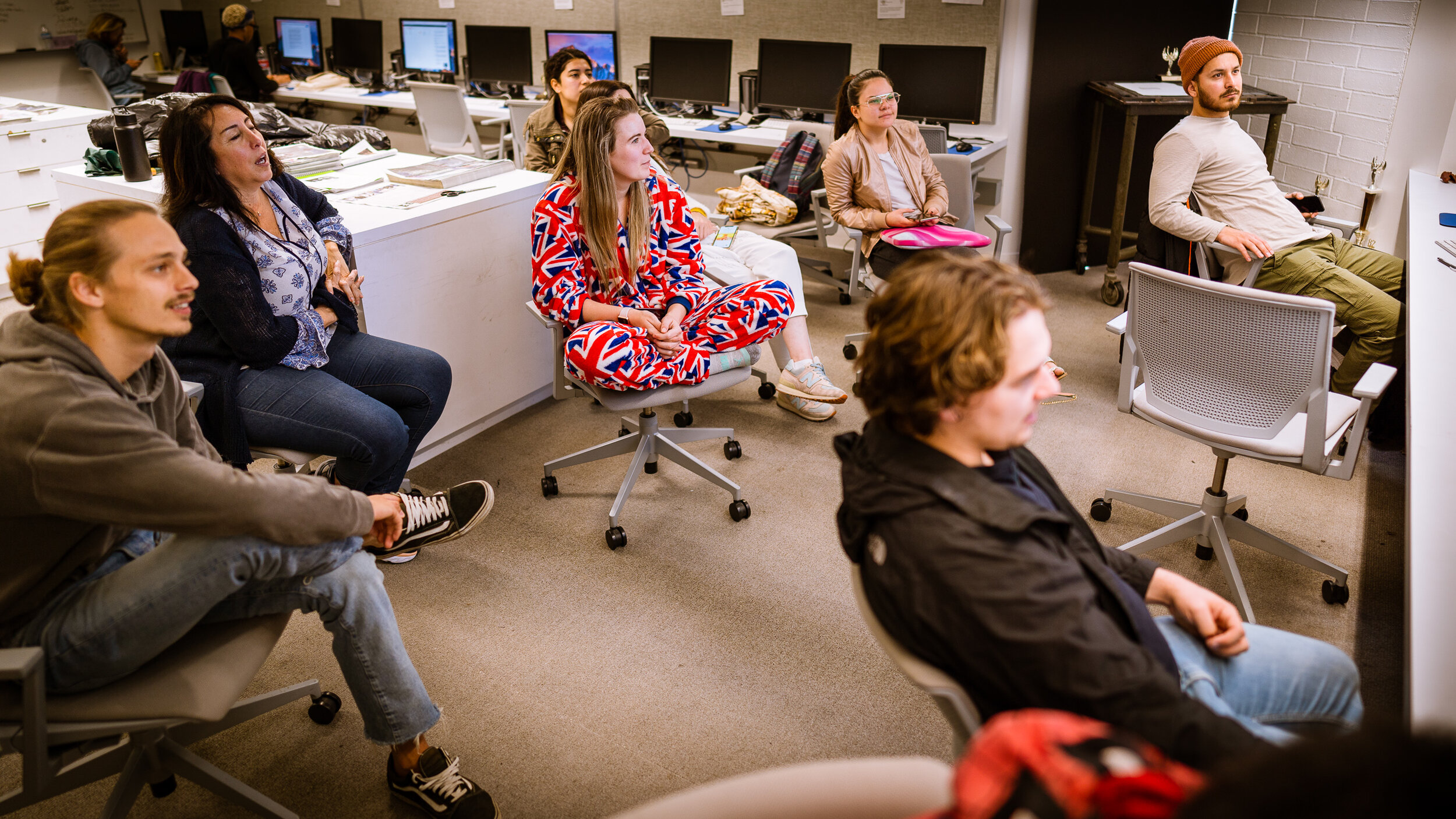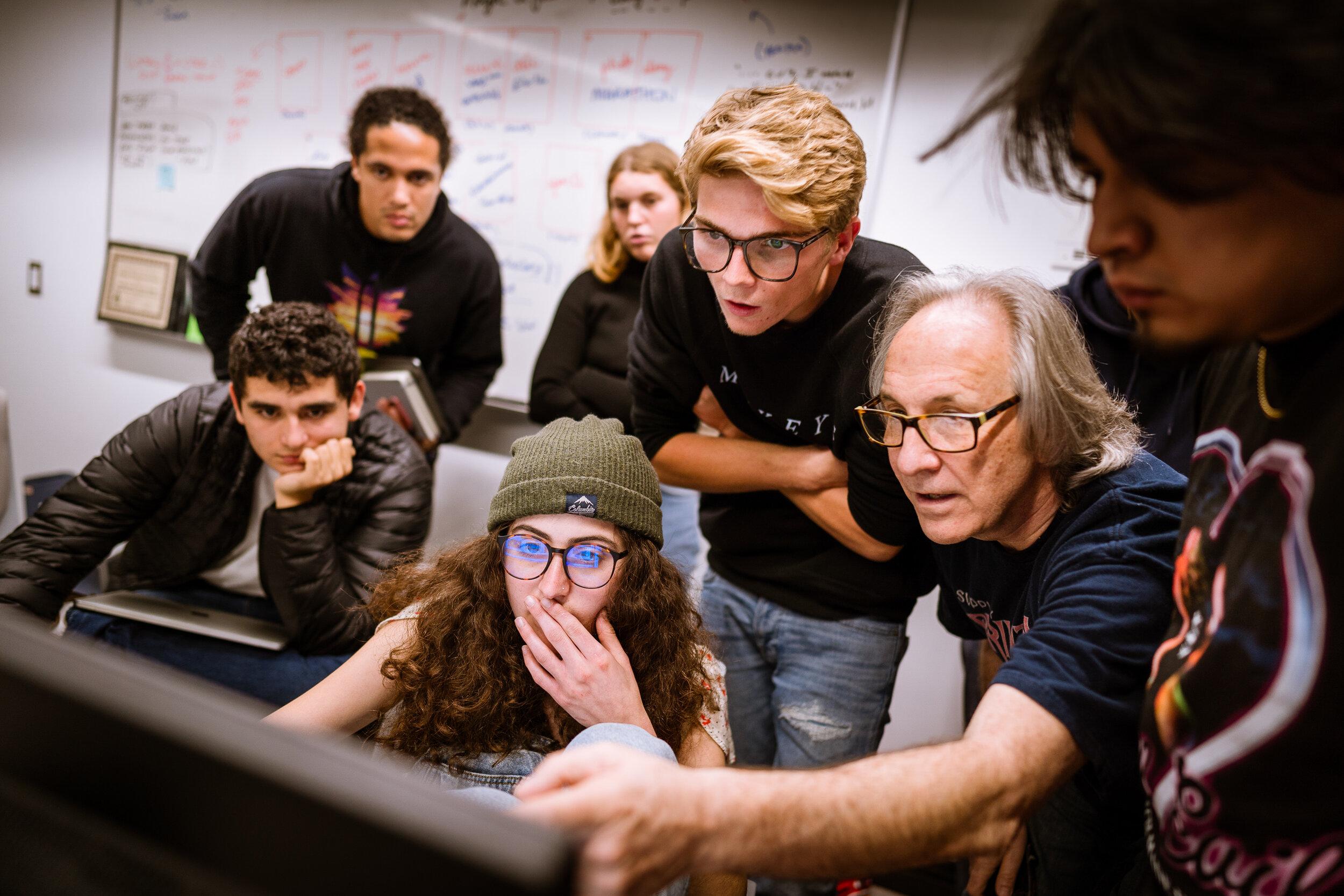How the Corsair Pulled Through
Showing up to the Center for Media and Design on March 12 felt unlike any other day at Santa Monica College (SMC). It was only a month into the Spring Semester, and my first on the Corsair staff. After just our first few meetings I wished I had signed up for the course earlier, knowing this was to be my last semester at SMC before transferring in the Fall. I could already see my skills as a writer were drastically improving, I was pushing myself outside of my comfort zone as a journalist, and I finally felt like I had found my community at SMC. As we filed into the newsroom that day, it dawned on me how while I still wished I had been a part of the staff sooner, it was now for a new set of reasons.
Ashanti Blaize-Hopkins and Gerard Burkhart meet with the Corsair staff in the newsroom at the Center for Media and Design. (Glenn Zucman | The Corsair)
There was a sense of comfort when our journalism professor, Ashanti Blaize-Hopkins, began class that day along with Gerard Burkhart, our photojournalism professor. The two, who both serve as advisors for the Corsair, led a discussion of how the class would continue online. Up until that point the biggest change we had prepared for was that Blaize-Hopkins would be going on maternity leave come spring break and professor Sharyn Obsatz would be stepping in to fill her role.
“I think from the beginning, Burkhart and I decided that it was best for us to be transparent with the staff,” said Blaize-Hopkins. “I think, by us being honest about how we didn't know how this is gonna go, you know, by us just saying, ‘Look, guys, we're trying this, this is new, this is bizarre territory, and we're gonna try and make it work. But you know, we need your help to try and make it work.’”
Reality hit on March 19, the first Zoom session for our newly online class. While only a week had passed since we had seen each other in person, it felt like a lifetime. Many of us on the call were in the same boat, dealing with spotty wifi, learning to mute ourselves if we weren’t talking, and some parents now finding a balance between their classes and kids all while at home.
Despite it all, we showed up that day because we were determined. We wanted to keep writing, to better ourselves, and grow from this experience.
Managing editor, Jack Hughes, along with Editor-In-Chief, Jackie Sedley, work together on the Corsair layout at the Center for Media and Design. (Glenn Zucman | The Corsair)
That dedication was felt by the Corsair’s Editor-In-Chief, Jackie Sedley. “I have never seen a group of people who only knew each other for a month in person, find a way to continue to collaborate, continue to grow, and continue to increase their abilities, week by week, even with a newly virtual format,” said Sedley.
Sedley along with managing editor Jack Hughes, met that following Sunday where they decided the Corsair would continue to produce a bi-weekly newspaper that solely lived online. “The PDF publication was something that was really important to both Jack and I. It was something that we felt like showed our abilities to collaborate.” said Sedley. “We knew that we wanted to keep producing those PDFs, even if they weren't going to be printed.”
Hughes noted the educational opportunity producing a college newspaper provides, “Jackie and I, we have tried to maintain this environment for the entire staff. This is a huge learning experience, and we didn't really want to give it up.”
He also addressed the important role the Corsair serves to the students of SMC. “There's so many stories at SMC that would go completely unheard without a student newspaper,” said Hughes. “So for us, it was about sharing that news that other outlets likely would not be covering, producing media for people to read. Having an avenue for people to reach out and to hear their stories.”
The new normal, as with many classes at SMC, the Corsair staff meets along with professors Sharyn Obsatz and Gerard Burkhart to discuss the publication and go over critiques from the last paper. (Glenn Zucman | The Corsair)
Not wanting to limit stories visually, many staff members took it upon themselves to go out on the scene to capture this moment in time including Maxim Elramsisy, a staff photographer for the Corsair. “When I go out into the field, I always have a backpack full of my camera gear, but then I have a fanny pack that I keep, just of stuff that I need to have handy with some gloves, face masks, some purell, a notebook and a pen,” said Elramsisy.
Knowing the need for compelling photos, Elramsisy decided to drive down to San Pedro to capture the United States Navy Hospital Ship Mercy, which had docked in Los Angeles at the end of March to help treat non-COVID-19 patients. “It was pretty hectic because a lot of people were going down there to see it. And it wasn't really an ideal environment to be in,” said Elramsisy, whose photo ended up being the cover shot for the Corsair’s special edition on Coronavirus.
With the base work of writing articles and taking photos done, we head into production day as prepared as we can be. Production day takes place every other Tuesday, at 9:30 a.m. sharp and is an all day event. Once Sedley and the editors brief us on what's going into that issue, we split up into two groups, read-throughs and layout.
Read-throughs are where we get a team of eyes to look at each piece we’re putting in the issue. Making use of Zoom’s screen share function, one person volunteers to read the article aloud as the rest of us follow along, stopping after each paragraph to allow the group to give notes on structure, grammar, and making sure it follows the Associated Press (AP) Style Guide.
Once the article is finished, it’s uploaded to Google Drive for the layout team, made up by Sedley and Hughes who tag team by taking on different sections. They use Sedley’s computer as the home base as they insert the articles in as soon as they’ve gone through the read-through process and format both the stories and visuals.
We all rejoin on Zoom for one final look through before we upload our publication onto the website. It’s a rewarding moment as it's the first time many of us get to see how our hard work throughout the day has come together. We stay on the call as the PDF is uploaded online by Sedley, replicating the moment we’d gather around her desk with anticipation as she sent it off to the printer, bursting into cheer when we’d gotten confirmation the print shop had received it.
This semester hasn’t been what any of us intended. Absent of the moments of sitting around the newsroom, movie nights filled with team bonding, and grabbing lunch together from the food trucks down the street. However, now more than ever I’m incredibly grateful for the team I’ve gotten to know throughout this course. Especially over the past few days I’ve witnessed our photographers and writers as they cover the many Black Lives Matters protests taking place throughout Los Angeles, showcasing their dedication in the midst of a global pandemic. It’s apparent that this is a team that takes their role seriously, telling the stories that need to be told, and understanding it’s their responsibility as a journalist to tell them.



















